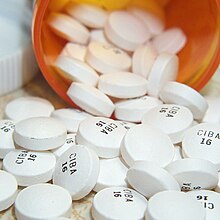Abbreviated New Drug Application
| Regulation of therapeutic goods in the United States |
|---|
 |
|
Prescription drugs Over-the-counter drugs |
An Abbreviated New Drug Application (ANDA) is an application for a U.S. generic drug approval for an existing licensed medication or approved drug.
The ANDA is submitted to FDA's Center for Drug Evaluation and Research, Office of Generic Drugs, which provides for the review and ultimate approval of a generic drug product. Once approved, an applicant may manufacture and market the generic drug product to provide a safe, effective, low cost alternative to the American public. Electronic submissions of ANDAs have grown by 70% since November 2008.[1] The Section IV challenge has been credited with suppressing new drug innovation.[2]
A generic drug product is one that is comparable to a patented drug product in dosage form, strength, route of administration, quality, performance characteristics and intended use. All approved products, both innovator and generic, are listed in FDA's Approved Drug Products with Therapeutic Equivalence Evaluations (Orange Book).
Generic drug applications are termed "abbreviated" because (in comparison with a
Using
Notes
- ^ Kathie Clark (June 30, 2009). "DIA Update: News from the FDA". The eCTD summit.
- S2CID 26207932.
![]() This article incorporates public domain material from websites or documents of the United States Department of Health and Human Services.
This article incorporates public domain material from websites or documents of the United States Department of Health and Human Services.
